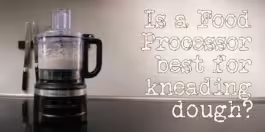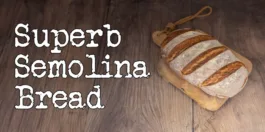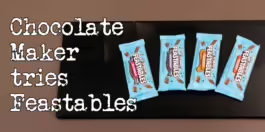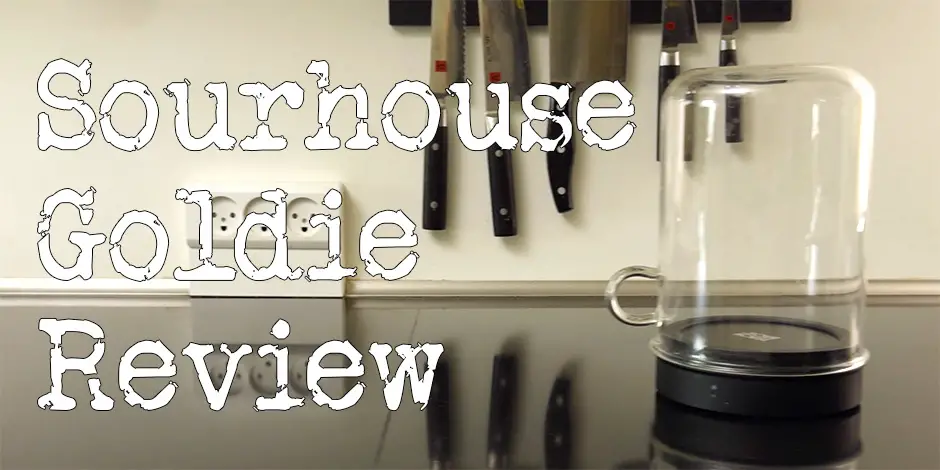Faith is a powerful thing. Faith is tied to religion. Different religions come with certain rules and traditions that have shaped people’s lives on our planet for thousands of years. In Judaism, they have a resting day called Shabbat, which starts Friday evening at sunset. Invariably intertwined with observing the Shabbat is the braided bread Challah. This is my recipe for sourdough challah.
Disclaimer! This is not an article about religion or my views on it, but if you are a regular reader you know I always like to look into the backstory of the things I present here.
If you are just here for the recipe, you can press the button underneath to be automagically transported to the recipe:
Jump to Recipe Jump to VideoSo what is this challah about?
Challah is a bread in Jewish cuisine that has a special ceremonial purpose. The bread is often as part of Shabbat and other major Jewish holidays.
The word challah is Hebrew but is known in Jiddisch under a variety of different names in different dialects like khale, barches, bukhte, dacher, or berkhes.
The bread is related to Kalach in Russia and Eastern Europe, which is also an enriched bread, braided but often circular. They are often used as part of worship as well, for Christmas or Easter.
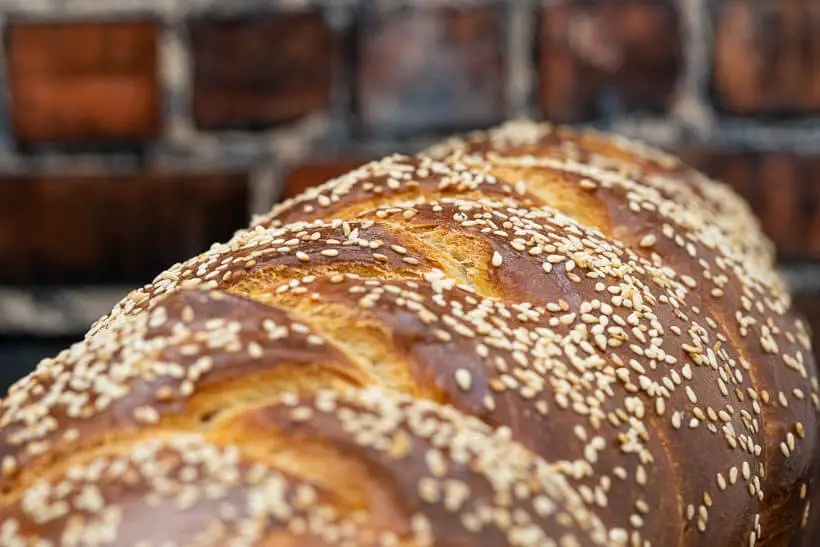
Classically challah is topped with sesame seeds, poppy seeds, or anise. Not uncommonly raisins and/or saffron are also added to the dough.
The dough is an enriched dough, but unlike brioche, it does not contain milk or butter, because it’s normally prepared parve, which means it’s both without meat and dairy. Instead, it relies on fat from vegetable oil, eggs, and honey or sugar to get the rich luxurious texture.
The formula in this sourdough challah recipe
The challah bread is made with enriched dough. It’s enriched with oil, honey, and eggs.
To minimize the sourness of the starter I am using a stiff levain, which is made from your regular 100% hydration starter (to minimize the need for having multiple starters). A stiff starter can grow as high as your regular starter.
It uses this formula:
| Weight | Ingredient | Baker's Percentage |
|---|---|---|
| 39g | starter (100% hydration) | 35.1% |
| 111g | bread flour | 100.0% |
| 57g | water | 51.4% |
The dough itself is made using bread flour, a bit of water, quite a lot of egg, honey, oil, and salt.
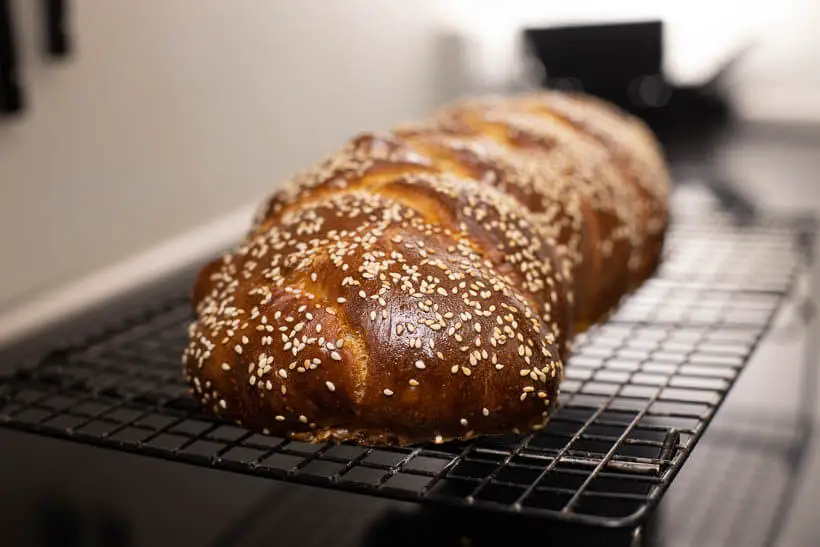
The hydration of this dough is not possible to calculate because of the high percentages of additions, but it feels like a lean dough of somewhere in the range of 55-60% hydration. Tacky, but not sticky.
This is the formula:
| Weight | Ingredient | Baker's Percentage |
|---|---|---|
| 413g | flour | 100.0% |
| 62g | water | 15.0% |
| 186g | egg | 45.0% |
| 57g | oil | 13.8% |
| 67g | honey | 16.2% |
| 8g | salt | 1.9% |
If you want to play around with the formula, you can do so in my bread calculator.
Conclusion of this sourdough challah recipe
There is no doubt, that this bread is a looker. The braids break up the surface and the toasted sesame seeds and the deeply caramelized crust look absolutely gorgeous.
The bread itself feels light. The crust is thin, super soft, and smells wonderful.
The crumb is incredibly soft, filled with tiny holes. You can see the gluten structure in the crumb from the braids, which makes it break up in circular patterns.
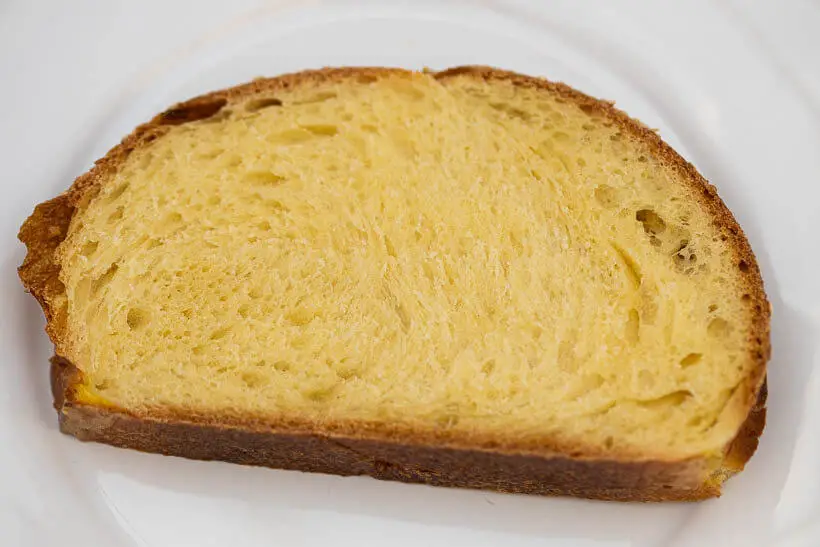
The taste is great. You can taste the nutty notes from the flour and it has an absolutely wonderful mouthfeel. This is not bread for the weekdays, but a weekend bread.
It’s perfect with some gorgeous butter and a sprinkling of coarse salt.
Share this recipe for sourdough challah on social media
This is my recipe for sourdough challah. I hope you will try to make this gorgeous and delicious bread.
If you make it and share it on Instagram, please tag me as @foodgeek.dk so I can see what you made. That would make me very happy.
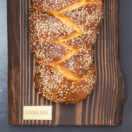
Sourdough Challah
Ingredients
Stiff levain
- 53 g sourdough starter
- 150 g bread flour
- 76 g water
Dough
- 413 g bread flour
- 62 g water
- 186 g eggs about 4 large
- 57 g neutral flavored oil e.g. rapeseed, peanut, sunflower
- 67 g honey
- 8 g salt
- 207 g levain
Egg wash
- egg
- salt
Topping
- sesame seeds
- poppy seeds
- kosher salt
Instructions
Making the stiff levain – the evening before
- Mix everything for the levain build. Knead it so that it's thoroughly mixed.
- Put it in a glass container and press it flat.
- Put an elastic band around the container where the top of the levain is, so you can monitor how much it grows.
- Leave it to grow the night over until it's reached its peak. It takes somewhere around eight to twelve hours.
Mixing the dough – around 8:00/8a.m.
- In a large bowl add 62g water, 186g eggs, 8g salt, 57g oil and 67g honey. Mix it until the salt has dissolved.
- Mix in 413g bread flour by hand until you have a shaggy ball.
- Add 207g of the stiff lavain and knead by hand until you have a firm and smooth dough. About 8-10 minutes.
- The dough should be tacky but not sticky. If it seems a bit too wet, knead in a bit of flour. If it seems to dry, knead in water by the tablespoon.
Bulk fermentation – around 8:30/8:30 a.m.
- Place the dough in a clean bowl and let it ferment somewhere warm for 2 hours. It will probably not rise at all; this is fine.
Shaping and final proof – around 10:30/10:30 a.m.
- You can bake this as a 1000g loaf or divide it into two smaller 500-gram loaves. You can divide them into 16 60-gram rolls if you want to make challah rolls.
- Braid or shape the dough. Watch my video to see how you do a classic Challah shape.
- Cover with plastic wrap and let proof until tripled in size, about 5 hours.
- Around 4½ hours into the proof, gauge the dough. If it's almost tripled and when poked, the dough only springs back a little, preheat the oven to 180°C/350°F/Gas mark 4.
Baking – around 16:00/4:00 p.m.
- Gauge the dough again. Poke the dough with a wet finger. The dough is ready to be baked, if it makes an indentation that doesn't spring back. If not, wait a bit more.
- Heat the oven to 180°C/350°F.
- Make an egg wash by mixing an egg with a pinch of salt.
- Brush the bread with the egg wash.
- Sprinkle with the topping(s) of your choice. I used sesame seeds.
- Baking a large loaf takes about 40 minutes, smaller loaves take about 30 minutes, and rolls take 15 minutes.
- If your oven heats unevenly, you may want to turn the sheets halfway during baking, to get even browning.
- For the bread to be done, the internal temperature should be around 99°C/210°F.
- When the loaves/rolls are done, remove them from the oven and let cool completely on a wire rack.




